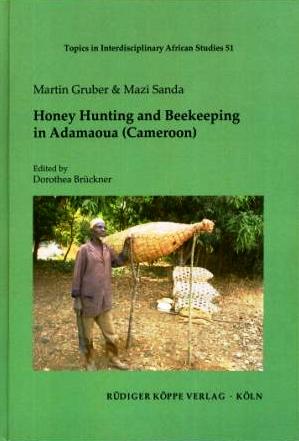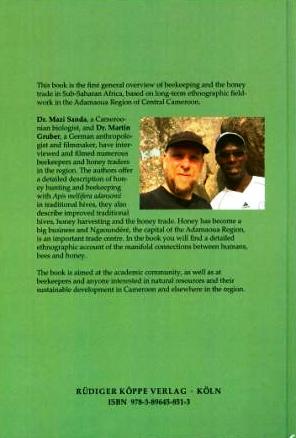



This book is the first general overview of beekeeping and the honey trade in Sub-Saharan Africa, based on long-term ethnographic fieldwork in the Adamaoua Region of Central Cameroon.
Dr. Mazi Sanda, a Cameroonian biologist, and Dr. Martin Gruber, a German anthropologist and filmmaker, have interviewed and filmed numerous beekeepers and honey traders in the region. The authors offer a detailed description of honey hunting and beekeeping with Apis mellifera adansonii in traditional hives, they also describe improved traditional hives, honey harvesting and the honey trade. Honey has become a big business and Ngaoundéré, the capital of the Adamaoua Region, is an important trade centre.
In the book you will find a detailed ethnographic account of the manifold connections between humans, bees and honey. The book is aimed at the academic community, as well as at beekeepers and anyone interested in natural resources and their sustainable development in Cameroon and elsewhere in the region.
CONTENTS
Preface / Introduction
1 Research on Beekeeping in the Adamaoua Region
2 Bees and Beekeeping in Africa and the Adamaoua Region
3 Honey Hunting: 3.1 Honey Hunting from Earth Nests 3.2 Honey Hunting from Hollow Trees 3.3 Honey Hunting from Stingless Bees 3.4 Honey Hunting with the Honey Guide Bird (Indicator indicator) 3.5 Honey Hunting in Local Oral History
4 Beekeeping with Conical Beehives: 4.1 The Manufacturing of Hives 4.2 Beekeeping Practice 4.3 Honey Harvesting 4.4 Innovations in Beekeeping
5 Honey Trade: 5.1 Different Categories of Honey Traders 5.2 Places of Trading Honey 5.3 Recent Developments in the Honey Trade 5.4 Adulterated Honey 5.5 The Use of Honey
6 Potentials and Challenges Related to Beekeeping: 6.1 Environmental Degradation and Climate Change 6.2 Security Issues 6.3 Beekeeping and Development
Conclusion / References
Under these links you will find further ethnobotanical / ethnozoological accounts, comprising information on honey production, nutrition and use of resources in Africa:
Based on interviews and time spent with beekeepers in the Adamaoua region, this book provides a good introduction to the history and current status of honey production in Cameroon. The authors are positive towards local styles of beekeeping and beehives and discuss their efficacy and affordability for people on low incomes. Beautiful descriptions and photographs of the hive making process are included. Unfortunately, the book omits market and production information about beeswax, which in recent years has become a valuable export crop for the region.
Sean Lawson in Bees for Development Journal, 134 / March 2020, 14
© 2025 by Rüdiger Köppe Verlag – www.koeppe.de